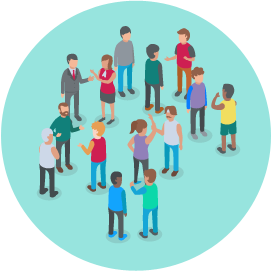Références bibliographiques :
Aristote. (2015). Les Politiques. Flammarion. https://editions.flammarion.com/les-politiques/9782081358775
Bacon, A. K., & Engerman, B. (2018). Excluded, then inebriated: A preliminary investigation into the role of ostracism on alcohol consumption. Addictive Behaviors Reports, 8(May), 25–32. https://doi.org/10.1016/j.abrep.2018.05.002
Baumeister, R. F., & Leary, M. R. (1995). The Need to Belong: Desire for Interpersonal Attachments as a Fundamental Human Motivation. Psychological Bulletin, 117(3), 497–529. https://doi.org/10.1037/0033-2909.117.3.497
Baumeister, R. F., Nathan Dewall, C., Ciarocco, N. J., & Twenge, J. M. (2005). Social exclusion impairs self-regulation. Journal of Personality and Social Psychology, 88(4), 589–604. https://doi.org/10.1037/0022-3514.88.4.589
Baumeister, R. F., Twenge, J. M., & Nuss, C. K. (2002). Effects of social exclusion on cognitive processes: Anticipated aloneness reduces intelligent thought. Journal of Personality and Social Psychology. https://doi.org/10.1037/0022-3514.83.4.817
Buelow, M. T., & Wirth, J. H. (2017). Decisions in the face of known risks: Ostracism increases risky decision-making. Journal of Experimental Social Psychology, 69, 210-217.
Cloutier, R. M., Anderson, K. G., Kearns, N. T., Carey, C. N., & Blumenthal, H. (2021). An experimental investigation of peer rejection and social anxiety on alcohol and cannabis use willingness: Accounting for social contexts and use cues in the laboratory. Psychology of Addictive Behaviors, 35(8), 887–894. https://doi.org/10.1037/adb0000711
Cooper, M. L. (1994). Motivations for alcohol use among adolescents: Development and validation of a four-factor model. Psychological Assessment, 6(2), 117–128. https://doi.org/10.1037/1040-3590.6.2.117
Coumans, M., & Spreen, M. (2003). Drug use and the role of homelessness in the process of marginalization. Substance Use & Misuse, 38(3-6), 311-338. https://doi.org/10.1081/JA-120017376
DeWall, C. N., & Pond, R. S. (2011). Loneliness and smoking: The costs of the desire to reconnect. Self and Identity, 10(3), 375–385. https://doi.org/10.1080/15298868.2010.524404
Ferris, L. J., Jetten, J., Hornsey, M. J., & Bastian, B. (2019). Feeling Hurt: Revisiting the Relationship Between Social and Physical Pain. Review of General Psychology, 108926801985793. https://doi.org/10.1177/1089268019857936
Freedman, G., Williams, K. D., & Beer, J. S. (2016). Softening the blow of social exclusion: The responsive theory of social exclusion. Frontiers in Psychology, 7(OCT), 1–17. https://doi.org/10.3389/fpsyg.2016.01570
Hales, A. H., Williams, K. D., & Eckhardt, C. I. (2015). A participant walks into a bar…: Subjective intoxication buffers ostracism’s negative effects. Social Psychology, 46(3), 157–166. https://doi.org/10.1027/1864-9335/a000235
Hubert, T. (2017). 94% des collégiens déclarent se sentir bien dans leur collège. Note d’information du Ministère de l’Éducation Nationale et de la DEPP, 17(30).
Lakin, J. L., & Chartrand, T. L. (2003). Using nonconscious behavioral mimicry to create affiliation and rapport. Psychological Science, 14(4), 334–339. https://doi.org/10.1111/1467-9280.14481
Maner, J. K., DeWall, C. N., Baumeister, R. F., & Schaller, M. (2007). Does social exclusion motivate interpersonal reconnection? Resolving the “porcupine problem.” Journal of Personality and Social Psychology, 92(1), 42–55. https://doi.org/10.1037/0022-3514.92.1.42
Maniglio, R. (2015). Association between peer victimization in adolescence and cannabis use: A systematic review. Aggression and Violent Behavior, 25, 252–258. https://doi.org/10.1016/j.avb.2015.09.002
March, J. C., Oviedo-Joekes, E., & Romero, M. (2006). Drugs and social exclusion in ten European cities. European Addiction Research, 12(1), 33–41. https://doi.org/10.1159/000088581
McCabe, S. E., Bostwick, W. B., Hughes, T. L., West, B. T., & Boyd, C. J. (2010). The relationship between discrimination and substance use disorders among lesbian, gay, and bisexual adults in the United States. American Journal of Public Health, 100(10), 1946–1952. https://doi.org/10.2105/AJPH.2009.163147
Mead, N. L., Baumeister, R. F., Stillman, T. F., Rawn, C. D., & Vohs, K. D. (2011). Social Exclusion Causes People to Spend and Consume Strategically in the Service of Affiliation. Journal of Consumer Research, 37(5), 902–919. https://doi.org/10.1086/656667
Meisel, S. N., Colder, C. R., Bowker, J. C., & Hussong, A. M. (2018). A longitudinal examination of mediational pathways linking chronic victimization and exclusion to adolescent alcohol use. Developmental psychology, 176(3), 139–148. https://doi.org/10.1037/dev0000569.A
Mohr, C. D., Tennen, H., Temple, M., Clark, J., Armeli, S., Todd, M., & Carney, M. A. (2005). Moving beyond the keg party: A daily process study of college student drinking motivations. Psychology of Addictive Behaviors, 19(4), 392–403. https://doi.org/10.1037/0893- 164X.19.4.392
O’Reilly, J., Robinson, S. L., Berdahl, J. L., & Banki, S. (2015). Is negative attention better than no attention? The comparative effects of ostracism and harassment at work. Organization Science, 26(3), 774–793. https://doi.org/10.1287/orsc.2014.0900
Platt, B., Kadosh, K. C., & Lau, J. Y. F. (2013). The role of peer rejection in adolescent depression. Depression and Anxiety, 30(9), 809–821. https://doi.org/10.1002/da.22120
Prinstein, M. J., & Aikins, J. W. (2004). Cognitive moderators of the longitudinal association between peer rejection and adolescent depressive symptoms. Journal of Abnormal Child Psychology, 32(2), 147–158. https://doi.org/10.1023/B:JACP.0000019767.55592.63
Rabinovitz, S. (2014). Drowning your sorrows? Social exclusion and anger effects on alcohol drinking. Addiction Research and Theory, 22(5), 363–370. https://doi.org/10.3109/16066359.2013.857661
Scheim, A. I., Bauer, G. R., & Shokoohi, M. (2017). Drug use among transgender people in Ontario, Canada: Disparities and associations with social exclusion. Addictive Behaviors, 72(March), 151–158. https://doi.org/10.1016/j.addbeh.2017.03.022
Twenge, J. M., Catanese, K. R., & Baumeister, R. F. (2003). Social exclusion and the deconstructed state: time perception, meaninglessness, lethargy, lack of emotion, and self-awareness. Journal of personality and social psychology, 85(3), 409.https://doi.org/10.1037/0022-3514.85.3.409
Wesselmann, E. D., & Parris, L. (2021). Exploring the Links Between Social Exclusion and Substance Use, Misuse, and Addiction. Frontiers in Psychology, 12, 674743. https://doi.org/10.3389/fpsyg.2021.674743
Williams, K. D. (2002). Ostracism: The power of silence. Guilford Press.
Williams, K. D. (2007). Ostracism: The Kiss of Social Death. Social and Personality Psychology Compass, 1(1), 236–247. https://doi.org/10.1111/j.1751-9004.2007.00004.x
Williams, K. D. (2009). Ostracism. A Temporal Need-Threat Model. Advances in Experimental Social Psychology. https://doi.org/10.1016/S0065-2601(08)00406-1
[1] OTCRA : Observatoire Territorial des Conduites à Risques de l’Adolescent (Unité Mixte de Service au sein de la Maison des Sciences de l’Hommes-Alpes, CNRS, Univ. Grenoble Alpes, Univ. Savoie Mont Blanc). https://otcra.fr/categories/conduites-a-risque/addiction-substances/alcool/

